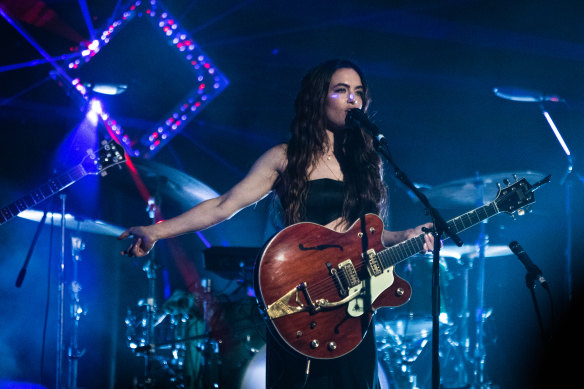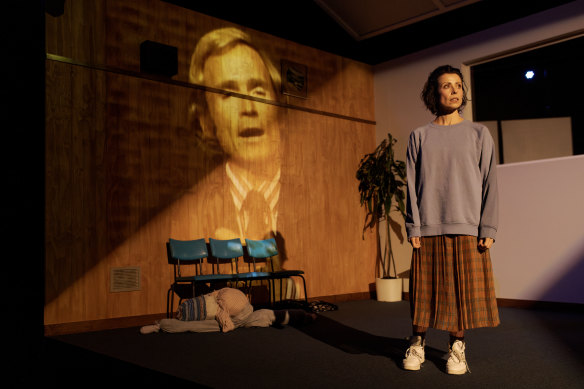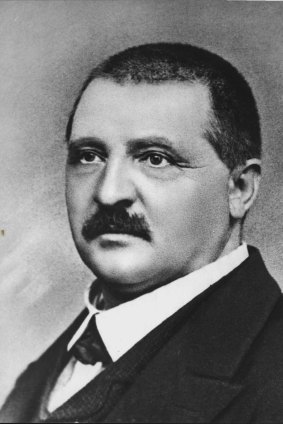This was published 3 months ago
Angus & Julia Stone would make a great Angus & Julia Stone covers band
By Shamim Razavi, Cassie Tongue and Peter McCallum
Angus & Julia Stone
State Theatre, August 7
Reviewed by SHAMIM RAZAVI
★★★
Angus & Julia Stone would make a great Angus & Julia Stone covers band. They are already halfway there, with a very Angus & Julia take on Neil Young’s Harvest Moon for the encore and a Miley Cyrus cover in the main set, but imagine if they went the whole hog and covered their own songs.
Gone, hopefully, would be the blatant pastiche of others’ music – Bon Iver’s Skinny Love on Draw Your Swords, Lionel Richie’s Easy on Cape Forestier, Bob Dylan on countless others – and in their place might be the pure Angus & Julia Stone experience.

Julia Stone, along with brother Angus, delivered two hours of pleasing, consistent music.Credit: James Adams
On this night we get mere moments of what that musical chastity might achieve: on highlights Big Jet Plane and Yellow Brick Road they are distinctively masters of their own universe, those influences much better digested into their own sound.
What that sound lacks in complexity and variety, it compensates with an aesthetic unity that makes the concert cohere. On this night no jagged new experimental numbers push the boundaries; instead, two hours of pleasing, consistent, easy-listening music, sweetly sung.
Whether you enjoy those hours depends on the Vegemite test of whether you find Julia Stone’s voice affected or affecting. In a crowded field of cracked alt-female vocals, Julia’s grazed voice has a distinct richness, even if the accent and intonation are unmoored from her speaking voice.
Occasionally, briefly, she drops the facade and speak-sings in her natural voice, which sounds far more sincere and direct than the more forced range she inhabits for most of the show.
More reliably, Angus’ laid-back singing breaks the Julia spell as they broadly alternate the lead vocals from song to song. On his numbers there is also an emotional distance despite the direct simplicity of the lyrics and arrangements, but this distance plays as an Australian everyman who unwittingly finds himself in the spotlight.
Those everyman – and -woman – personas are effortlessly charming and lie at the core of their appeal to a devoted audience that connects on that everyday-person-from-Newport level.
No sibling rivalry here: these two recognise that each completes and improves the other, and an accomplished backing band – with notable banjo and guitar-hero solos from long-time collaborator Ben Edgar – rounds off a perfectly amiable show.
Angus & Julia Stone play the State Theatre on August 8 and 9.
Arlington
Reginald Theatre, Seymour Centre
August 7
Reviewed by CASSIE TONGUE
★★★
Picture a waiting room: a couple of chairs, a lamp, a window, piped music – a place to be endured rather than experienced.
When Arlington by Irish playwright Enda Walsh begins, our whole world is a waiting room – almost. Isla (Phaedra Nicolaidis) is waiting. Off to the side, there’s an ominous surveillance setup, and when a young man (Jack Angwin) arrives, it quickly becomes clear Isla is a captive subject who trades stories for positive rewards. She and the guards are clearly at deep ideological odds, but in his newness to the role and her (manic-pixie-dream-girl-like) grace, they form an unexpected bond.

Phaedra Nicolaidis plays Isla, who is being mysteriously held against her will.Credit: Philip Erbacher
What made the world this way? Why is this furtive love so unexpected? We never find out, and this nagging lack of substance plagues Arlington at every step, even when it takes its biggest swing – moving away from our star-crossed lovers and into another waiting room where another woman (Emma Harrison, also the choreographer) expresses her confinement through dance.
Not dark enough to demand we fully reckon with the gravity of its ideas and not whimsical enough to sell itself as a collection of beautifully told stories shot through with hope, Arlington is at its best a study of mood, built out with lightly romantic or threatening threads. It is an offering, a cup: you can pour your own loneliness and loss into it to feel replenished. It also, of course, may feel empty.
It’s directed with perhaps too-straightforward steadiness by Anna Houston – it’s hard to get lost in the piece’s inherent abstractness when it so resolutely marches through each scene. Aron Murray’s lights and projections – working in concert with Steve Toulmin’s sound – flesh out the scenes with dramatic cues: flashing reds, loud buzzers and tones, and a melancholic score.
It helps that Nicolaidis and Angwin are gently charming together and that Harrison, who must sell the most difficult extended interlude within the play, does so with compelling movement that demonstrates the enormity of the choice she must make. At this most human level, feelings creep up onstage and reach out to us.
Augustin Hadelich
Sydney Symphony Orchestra
Opera House Concert Hall
August 7
Reviewed by PETER McCALLUM
★★★★½
The sound Augustin Hadelich makes on the violin, once heard, is not easily forgotten, so completely does it blend transparent clarity with rich colour. Easing into the opening theme of Mendelssohn’s Violin Concerto after a bar and a half of orchestral vamping, the immediate impression was of golden sweetness as the melody climbed in overlapping bounds.
This gave way to fiery, nimble precision, driven by a spirit of mercurial lightness as the music developed and raced through an invigorating return. The arch of the second movement was an unbroken band, calm, warm and humane, while the last movement darted forward with breathtaking agility and bristling energy.

Aspiring heavenwards: Anton Bruckner.Credit: Fairfax
One listened like a child gripped by an engrossing story over the three connected movements until suddenly, like a dream, it was over.
To mark the bicentenary of Anton Bruckner’s birth, SSO chief conductor Simone Young chose to present the original version (1887) of his craggiest, most expansive symphony and the last the composer completed – Symphony No 8 in C minor.
This version was famously greeted with uncomprehending dismay by one of Bruckner’s most ardent champions, the conductor Hermann Levi, prompting considerable angst and major revisions. Paradoxically, one of the virtues of the original version is to hear, unvarnished and unadorned, the strengths and the failures of Bruckner’s lofty striving for light.
Young allowed the tousling, unsettled, opening idea of the first movement to set the tone, the tempo always moving forward restlessly. In this original version, Bruckner gives a hint of where this is going by ending the movement in a radiant glow, vigorously animated by the violins who, under concertmaster Andrew Haveron, cut through with gleaming incisiveness.
The revised, more familiar version changed this completely to end the movement in brooding self-doubt. After a quick second movement (with the original middle section, which was subsequently reworked), the soul of the performance was the third movement.
Moving through a wealth of beautifully balanced, sometimes spare, orchestral textures, set off by the dark solemnity of the choir of Wagner tubas at the back, it reached an iridescent climactic moment from string and brass.
The finale moved in great waves of sound, but haltingly so, continually changing tack to frustrate and disappoint triumphalist expectations. It reached a close in which the themes of the earlier movements returned bathed in sunlight as though their pain had dissolved. This version reveals a Bruckner who, over a long span, aspires heavenwards and, if he doesn’t quite reach it, is not going to gloss over the attempt.
The Booklist is a weekly newsletter for book lovers from books editor Jason Steger. Get it delivered every Friday.